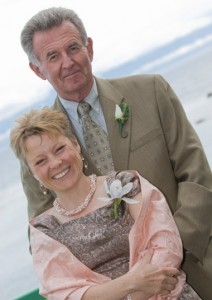Guest article by Elisabeth Paine, Alzheimer’s Caregiver
At the age of 42, I married a wonderful man. John was intelligent, competent, independent, and fun. We laughed a lot. We talked about growing old together, traveling, and building memories. That vision shattered about eight years later when John at age 65 was diagnosed with Alzheimer’s disease (AD).
I suspected something was wrong long before we heard the official news. I had watched my grandmother then my father, and now my husband be slowly destroyed by dementia.
Now at 53, I care full time for John as he suffers from this irreversible, progressive, and heartbreaking disease. Although I fear for my husband as he struggles with his daily challenges, I am also worried about losing myself to this new set of responsibilities … forgetting who I was and who I am.
I see my new life as existing in three concentric circles.
The innermost circle is for John. Caregiving is not a natural role for me and I have to work hard at it. I try to slow down, to be a lot more patient. Both are a constant struggle. I read books and blogs and take classes, all to educate myself, to develop techniques and learn about the disease.
The next bigger circle is for me and the support group for early onset spouses, which I started. Our issues are different than those of older people with Alzheimer’s and we help each other cope by sharing knowledge, techniques, laughter, and providing a safe place to vent. Starting this group let me fight back a little against this disease.
My biggest “fight back” is my outermost circle. This is where I participating in Alzheimer’s research as John’s study partner. This circle is for both of us, for his sons, and for future generations. Alzheimer’s is currently not just incurable but untreatable. The available drugs can alleviate some of the symptoms, but they don’t slow the disease.
Joined a Clinical Trial
We joined a clinical trial, led by the Alzheimer’s Disease Cooperative Study (ADCS), for two reasons. The personal reason was that it gave John access to a potential new treatment that might help him. That was a long shot, though. The bigger reason was to pull some good out of our situation by contributing to a future cure. John is very proud to be contributing to science.
There are over five million Americans today living with Alzheimer’s and nearly 15 million Alzheimer’s caregivers like me. My brother, my stepsons, and I all have a history of Alzheimer’s in the family. I want a cure for us and for the millions of other families like us before this disease devastates another generation.
Fifty percent of people above age eighty will get this disease–yes, that means you and your family are on the firing line. And right now the pace of research is slowed because of a lack of volunteers!
Please get involved in AD Research
Please, please think about getting involved in AD research. We need people from all age groups–not just the elderly–and all levels of cognitive ability: “normal”, mild impairment, and people with Alzheimer’s. Do it for yourself, for your children, for the greater human good.
Studies like the Alzheimer’s Disease Neuroimaging Initiative (ADNI) are at the cusp of further discoveries that could help better treat AD, but need volunteers to be successful. To continue the momentum, we must spread the word that everyone can contribute in some way to finding a cure. Changing the face of AD is possible, but we can’t find the answers we need without volunteer partners in science.
Together we can beat Alzheimer’s disease once and for all. Please go to ADNI or call toll free 1-800-432-4380 to learn how you can help.










I don’t have any advice, but I know this topic will become a theme as more people find themselves in the same situation.
Thanks for taking the time to comment, Denise.